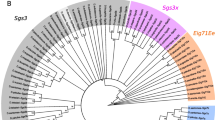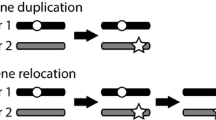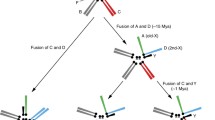Abstract
A genomic comparison of Drosophila melanogaster and Drosophila pseudoobscura provides a unique opportunity to investigate factors involved in sequence divergence. The chromosomal arrangements of these species include an autosomal segment in D. melanogaster which is homologous to part of the X chromosome in D. pseudoobscura. Using orthologues to calculate rates of nonsynonymous (dN) substitutions, we found genes on the X chromosome to be significantly more diverged than those on the autosomes, but it is not true for segment 3L-XR which is autosomal in D. melanogaster (3L) and X-linked in D. pseudoobscura (XR). We also found that the median dN values for genes having reproductive functions in either the male, the female, or both sexes are higher than those for sequences without reproductive function and even higher for sequences involved in male-specific function. These estimates of divergence for male sex-related sequences are most likely underestimates, as the very rapidly evolving reproductive genes would tend to lose homology sooner and thus not be included in the comparison of orthologues. We also noticed a high proportion of male reproductive genes among the othologous genes with the highest rates of dN. Reproductive genes with and without an orthologue in D. pseudoobscura were compared among D. melanogaster, D. simulans, and D. yakuba and it was found that there were in fact higher rates of divergence in the group without a D. pseudoobscura orthologue. These results, from widely separated taxa, bolster the thesis that sexual system genes experience accelerated rates of change in comparison to nonsexual genes in evolution and speciation.


Similar content being viewed by others
References
Al-Shahrour F, Díaz-Uriarte R, Dopazo J (2004) FatiGO:a web tool for finding significant associations of Gene Ontology terms with groups of genes. Bioinformatics 20:578–580
Andrews J, Bouffard GG, Cheadle C, Lu J, Becker KG, Oliver B (2000) Gene discovery using computational and microarray analysis of transcription in the Drosophila melanogaster testis. Genome Res 10:2030–2043
Betancourt AJ, Presgraves DC, Swanson WJ (2002) A test for faster X evolution in Drosophila. Mol Biol Evol 19:1816–1819
Carson HL (2003) Mate choice theory and the mode of selection in sexual populations. Proc Natl Acad Sci USA 100:6584–6587
Charlesworth B, Coyne JA, Barton NH (1987) The relative rates of evolution of sex chromosomes and autosomes. Am Nat 130:113–146
Civetta A, Singh RS (1995) High divergence of reproductive tract proteins and their association with postzygotic reproductive isolation in Drosophila melanogaster and Drosophila virilis group species. J Mol Evol 41:1085–1095
Civetta A, Singh RS (1998) Sex-related genes, directional selection, and speciation. Mol Biol Evol 15:901–909
Civetta A, Singh RS (1999) Broad-sense sexual selection, sex gene pool evolution, and speciation. Genome 42:1033–1041
Coulthart MB, Singh RS (1988) High level of divergence of male-reproductive-tract proteins, between Drosophila melanogaster and its sibling species, D. simulans. Mol Biol Evol 5:182–91
Counterman BA, Ortiz-Barrientos D, Noor MAF (2004) Using comparative genomic data to test for fast-X evolution. Evolution 58:656–660
Dobzhansky T (1970) Genetics of the evolutionary process. Columbia University Press, New York/London, pp 160–163
Drysdale A, Crosby MA, Flybase Consortium (2005) Flybase: genes and gene models. Nucleic Acids Res 33:D390–D395 (http://www.flybase.org/)
Fisher RA (1930) The genetical theory of natural selection. Oxford University Press, Oxford
Gonzalez J, Ranz JM, Ruiz A (2002) Chromosomal elements evolve at different rates in the Drosophila genome. Genetics 161:1137–1154
Jagadeeshan S, Singh RS (2005) Rapidly evolving genes of Drosophila: differing levels of selective pressure in testis, ovary and head tissues between sibling species. Mol Biol Evol 22(9):1793–1801
Parisi M, Nuttall R, Edwards P, Minor J, Naiman D, Lu J, Doctolero M, Vainer M, Chan C, Malley J, Eastman S, Oliver B (2004) A survey of ovary-, testis-, and soma-biased gene expression in Drosophila melanogaster adults. Genome Biol 5:R40
Ranz JM, Gonzalez J, Casals F, Ruiz A (2003) Low occurrence of transposition events during the evolution of the genus Drosophila. Evolution 57:1325–1335
Rice WR (1989) Analyzing tables of statistical tests. Evolution 43:223–225
Rice WR (1996) Sexually antagonistic male adaptation triggered by experimental arrest of female evolution. Nature 381:232–234
Richards S, Liu Y, Bettencourt BR, Hradecky P, Letovsky S, Nielsen R, Thornton K, Hubisz MJ, Chen R, Meisel RP, Couronne O, Hua S, Smith MA, Zhang P, Liu J, Bussemaker HJ, van Batenburg MF, Howells SL, Scherer SE, Sodergren E, Matthews BB, Crosby MA, Schroeder AJ, Ortiz-Barrientos D, Rives CM, Metzker ML, Muzny DM, Scott G, Steffen D, Wheeler DA, Worley KC, Havlak P, Durbin KJ, Egan A, Gill R, Hume J, Morgan MB, Miner G, Hamilton C, Huang Y, Waldron L, Verduzco D, Clerc-Blankenburg KP, Dubchak I, Noor MA, Anderson W, White KP, Clark AG, Schaeffer SW, Gelbart W, Weinstock GM, Gibbs RA (2005) Comparative genome sequencing of Drosophila pseudoobscura: chromosomal, gene, and cis-element evolution. Genome Res 15:1–18
Singh RS, Kulathinal R (2005) Male sex drive and the masculinization of the genome. Bioessays 27:518–525
Stevison LS, Counterman BA, Noor MAF (2004) Molecular evolution of X-linked accessory gland proteins in Drosophila pseudoobscura. J Hered 95:114–118
Strutevant AH, Novitski E (1941) The homologies of the chromosome elements in the genus Drosophila. Genetics 26:517–541
Swanson WJ, Vacquier VD (2002) Rapid evolution of reproductive proteins. Nat Rev Genet 3:137–144
Swanson WJ, Clark AG, Waldrip-Dail HM, Wolfner MF, Aquadro CF (2001) Evolutionary EST analysis identifies rapidly evolving male reproductive proteins in Drosophila. Proc Natl Acad Sci USA 98:7375–7379
Swanson WJ, Wong A, Wolfner MF, Aquadro CF (2004) Evolutionary expressed sequence analysis of Drosophila female reproductive tract identifies genes subject to positive selection. Genetics 168:1457–1465
Tamura K, Subramanian S, Kumar S (2004) Temporal patterns of fruit fly (Drosophila) evolution revealed by mutation clocks. Mol Biol Evol 1:36–44
Thornton K, Long MJ (2002) Rapid divergence of gene duplicates on the Drosophila melanogaster X chromosome. Mol Biol Evol 19:918–925
Torgerson DG, Singh RS (2003) Sex-linked mammalian sperm proteins evolve faster than autosomal ones. Mol Biol Evol 20:1705–1709
Torgerson DG, Kulathinal RJ, Singh RS (2002) Mammalian sperm proteins are rapidlyevolving: evidence of positive selection in functionally diverse genes. Mol Biol Evol 19:1973–1980
Tsaur S-C, Ting C-T, Wu C-I (2001) Sex in Drosophila mauritiana: a very high level of amino acid polymorphism in a male reproductive protein gene, Acp26Aa. Mol Biol Evol 18:22–26
Wernersson R, Pedersen AG (2003) RevTrans: multiple alignment of coding DNA from aligned amino acid sequences. Nucleic Acids Res 31:3537–3539
Wu C-I, Davis AW (1993) Evolution of postmating reproductive isolation:The composite nature of Haldane’s rule and its genetic basis. Am Nat 142:187–212
Yang Z (1997) PAML: a program package for phylogenetic analysis by maximum likelihood. Comput Appl BioSci 13:555–556
Zhang Z, Hambuch TM, Parsch J (2004) Molecular evolution of sex–biased genes in Drosophila. Mol Biol Evol 21:2130–2139
Acknowledgments
We would like to express our appreciation to R.A. Morton, J. Stone, J.P. Xu, R. Kulathinal, W. Haerty, and A. Civetta for providing critical comments and suggestions on the manuscript. Special thanks go to B. Whitty for help with alignment of sequences and to A. Musters for help with the statistical analysis. This work was funded by the Natural Science and Engineering Research Council of Canada through a discovery grant to R.S.S.
Author information
Authors and Affiliations
Corresponding author
Additional information
[Reviewing Editor: Dr. Willie J. Swanson]
Rights and permissions
About this article
Cite this article
Musters, H., Huntley, M.A. & Singh, R.S. A Genomic Comparison of Faster-Sex, Faster-X, and Faster-Male Evolution Between Drosophila melanogaster and Drosophila pseudoobscura. J Mol Evol 62, 693–700 (2006). https://doi.org/10.1007/s00239-005-0165-5
Received:
Accepted:
Published:
Issue Date:
DOI: https://doi.org/10.1007/s00239-005-0165-5




